Unravel the layered history of biblical Palestine, where ancient empires and shifting borders tell a story waiting to be discovered.

What Was Palestine in the Bible
Imagine firing up Google Maps to explore the ancient land of the Bible, only to find that the term 'Palestine' isn't as straightforward as it seems. You're about to embark on a journey through time, where geographic boundaries shift like desert sands, and the names and nations change with the tides of conquest and empire.
From the early Canaanite inhabitants to the era of Roman rule, the story of this land is a tapestry of cultural and political complexities. What awaits is a deeper understanding of how this region influenced, and was influenced by, the biblical narrative.
Curiosity piqued? Let's take a closer look.
Key Takeaways
- Palestine's diverse geography influenced settlement and economic activities in biblical times.
- The region was a melting pot of cultures, including Canaanites, Philistines, and Israelites.
- Roman rule and religious diversity significantly impacted the biblical narrative and Jesus' ministry.
- Political and religious tensions during Roman governance shaped key events, such as Jesus' crucifixion.
Geographic Boundaries Defined
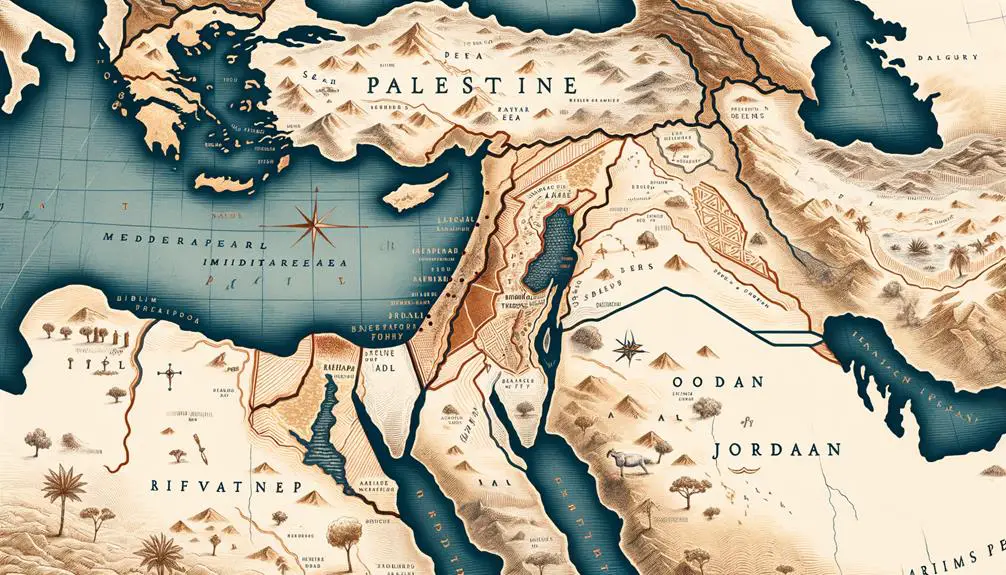
The geographic boundaries of ancient Palestine, as delineated in biblical texts, encompass a region defined by natural landmarks and ancient territorial markers. You'll find that its strategic position not only shaped its historical narrative but also its environmental and economic characteristics. Ancient Palestine was nestled between the Mediterranean Sea to the west and the desert to the east, creating a corridor for trade routes that connected Egypt with the Near East. This unique positioning meant that Palestine served as a bridge between continents, making it a focal point for commerce and cultural exchange.
Climate influences played a crucial role in the development and sustainability of this region. The diverse topography led to a variety of climate zones, from the fertile plains along the coast, conducive to agriculture, to the more arid and mountainous regions inland. These climatic conditions affected settlement patterns, agricultural practices, and the overall economy of ancient Palestine. The availability of water sources, such as the Jordan River and the Sea of Galilee, was vital for sustaining communities and facilitating trade.
The influence of trade routes on the region can't be understated. They brought not only goods but also ideas, technologies, and cultural practices from far and wide. The Incense Route, for instance, was instrumental in bringing wealth and foreign influences into the area. Consequently, ancient Palestine's geographic boundaries, defined by these natural and economic factors, shaped its role in the ancient world as a hub of trade, cultural exchange, and religious development.
Early Inhabitants and Cultures
Diving into the mosaic of early inhabitants and cultures, you'll discover that ancient Palestine was a crossroads for diverse peoples and civilizations, each contributing to the region's rich historical tapestry. This vibrant interchange not only shaped the social and political landscape but also fostered a unique blend of religious and cultural traditions.
To understand the complexity of early Palestine, consider these key elements:
- Canaanite Religion: The Canaanites, among the earliest known inhabitants, practiced a polytheistic religion that profoundly influenced the region's cultural and spiritual narrative. Their pantheon, featuring gods like Baal and Asherah, played a central role in daily life and ceremonial practices. Archaeological findings, including temples and religious artifacts, offer insights into their rituals and beliefs, highlighting their contribution to the region's religious diversity.
- Philistine Origins: The Philistines, arriving during the 12th century BCE, brought with them distinct cultural and technological advancements. Originating from the Aegean Sea region, their presence in Palestine marks a significant period of cultural exchange and conflict. The Philistines introduced new forms of pottery, weaponry, and architectural styles, leaving a lasting impact on the local culture.
- Cultural Interactions: The interaction between indigenous populations and incoming groups led to a dynamic and evolving cultural landscape. Trade routes facilitated the exchange of goods, ideas, and technologies, further enriching the cultural fabric of ancient Palestine.
Analyzing these elements, you'll appreciate the intricate web of influences that shaped early Palestinian society, laying the groundwork for the complex historical narratives that would follow.
The Israelite Conquest
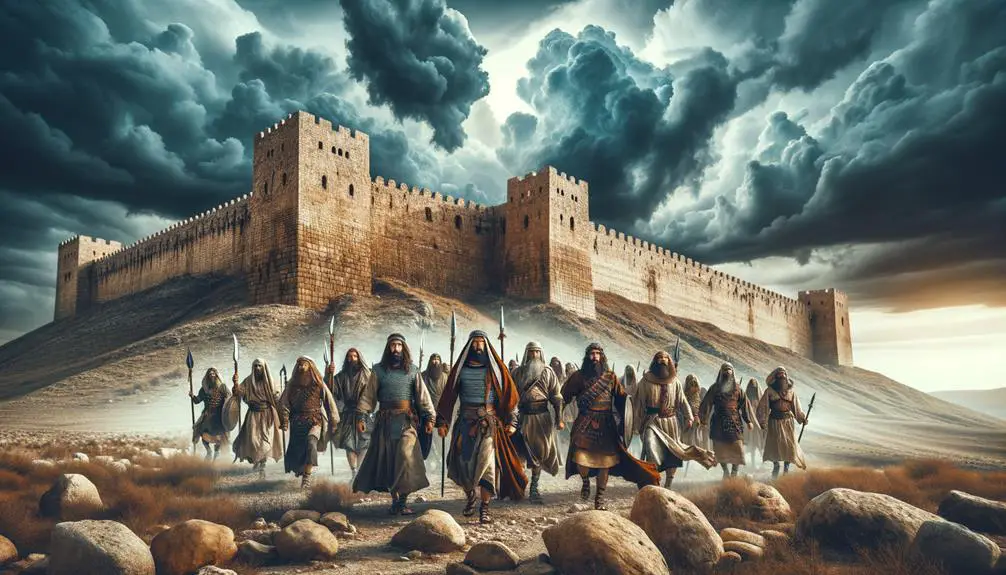
You'll observe that the Israelite conquest marks a pivotal moment in biblical history, particularly through the event of Jericho's walls falling. This narrative not only signifies a miraculous victory but also sets the stage for the subsequent tribal land division, a critical aspect in the establishment of the Israelite nation.
Analyzing these points sheds light on the complex relationship between divine intervention and human action in biblical accounts.
Jericho's Walls Fall
In analyzing the Israelite conquest of Canaan, a pivotal moment occurs when Jericho's walls famously collapse, marking a significant turning point in biblical history. This event, steeped in religious and historical significance, invites scrutiny through:
- Archaeological Methods: Excavations at Jericho have sought to validate the biblical narrative, employing advanced techniques to unearth evidence of the city's destruction layers.
- Modern Interpretations: Scholars analyze textual and material findings to reconcile biblical accounts with historical timelines, challenging or supporting traditional views.
- Cultural Impact: The story's inclusion in religious texts has influenced countless generations, symbolizing divine intervention and the fulfillment of a promised land.
Through objective analysis, these aspects offer a nuanced understanding of a complex event, bridging faith and historical inquiry.
Tribal Land Division
Following the conquest of Canaan, the division of tribal lands among the Israelites marked a critical phase in establishing their presence in the promised land. This process, deeply rooted in inheritance laws, was meticulously detailed to ensure equitable distribution among the twelve tribes.
However, the Levites were an exception; they received no territorial claim akin to their counterparts. Instead, Levitical cities were allocated to them, underscoring their distinct role in religious and societal functions. This allocation system underscored the intricate balance between secular and sacred duties, with land ownership intricately tied to societal structure and governance.
The division not only facilitated physical settlement but also reinforced tribal identities, ensuring each tribe's sustainability and cohesiveness within the broader Israelite community.
Kingdoms of Israel and Judah
You'll now explore the complexities surrounding the formation and division of the Kingdoms of Israel and Judah, a pivotal era in biblical history.
Key biblical figures emerge during this period, shaping the religious and political landscape through their actions and legacies.
Additionally, you'll examine major prophetic messages that not only critiqued the social injustices of the time but also offered visions of hope and restoration.
Formation and Division
After the reign of King Solomon, the united monarchy of Israel split into two distinct kingdoms: the northern Kingdom of Israel and the southern Kingdom of Judah. This division had profound implications, both in terms of religious significance and the archaeological evidence that helps us understand this pivotal period in biblical history.
Here are three key points to consider:
- Religious Significance: The split influenced the development of distinct religious practices and identities within each kingdom.
- Archaeological Evidence: Excavations have unearthed artifacts that provide insight into the cultural and political landscapes of both kingdoms.
- Historical Impact: The division set the stage for future conflicts and the eventual exile of both kingdoms, shaping the course of biblical history.
Key Biblical Figures
Exploring the kingdoms of Israel and Judah reveals key biblical figures who played pivotal roles in shaping the religious and political landscapes of these ancient entities.
Moses' leadership, for instance, is foundational, guiding the Israelites out of Egypt and establishing the covenantal laws that would define the nation's moral and societal framework. His contributions set the stage for the emergence of Israel and Judah as distinct geopolitical entities.
Similarly, David's Psalms deeply influenced the spiritual life of both kingdoms, offering expressions of faith, lament, and worship that resonated with the people's experiences. These texts not only enriched the religious practices of the time but also solidified David's legacy as a central figure in the cultural and religious identity of Israel and Judah.
Major Prophetic Messages
The prophetic messages delivered during the eras of the kingdoms of Israel and Judah profoundly shaped their spiritual and societal trajectories, emphasizing themes of justice, repentance, and divine intervention. These messages continue to influence modern interpretations and ethical considerations.
- Justice: Prophets like Amos and Micah critiqued societal injustices, urging leaders and citizens alike to uphold fairness and equity. Their calls resonate today in discussions about social justice and human rights.
- Repentance: Calls for repentance were central, emphasizing the need for personal and collective turning away from wrongdoing. This theme informs contemporary ethical dialogues about accountability and moral rectitude.
- Divine Intervention: The expectation of divine action to rectify injustices or guide the people provides a framework for understanding historical and present-day events within a theological context, influencing modern faith-based initiatives and perspectives.
Influence of Neighboring Empires
Throughout history, neighboring empires profoundly influenced Palestine's socio-political and religious landscape, shaping its narrative within the biblical context. Situated at the crossroads of Africa, Asia, and Europe, Palestine's strategic location along major trade routes made it a focal point for both commerce and conquest. This constant interaction facilitated not only economic prosperity but also cultural assimilation, as ideas, beliefs, and practices from Egypt, Mesopotamia, Persia, and later Hellenistic civilizations permeated the region.
You'll find that these exchanges weren't merely incidental but fundamentally transformed the social fabric of Palestine. The influx of foreign goods, coupled with the adoption of new agricultural techniques, spurred economic development. However, it was the assimilation of foreign deities and religious practices that most vividly illustrates the depth of cultural integration. This syncretism, while sometimes resisted, contributed to a rich tapestry of religious belief that's evident in biblical texts, reflecting a complex interplay of indigenous and foreign influences.
Moreover, the political landscape of Palestine was significantly shaped by its imperial neighbors. Assyrian, Babylonian, Persian, and later Greek dominions over Palestine not only altered its political boundaries but also its administrative structures and social hierarchies. These shifts prompted significant adaptations among the inhabitants of Palestine, influencing everything from governance and legal systems to religious practices.
In essence, the neighboring empires' influence on Palestine was profound, leaving indelible marks on its cultural, religious, and political development. This complex history of interaction and assimilation underpins the multifaceted narrative of Palestine found within the biblical texts, highlighting the region's pivotal role in the ancient Near Eastern world.
The Babylonian Exile
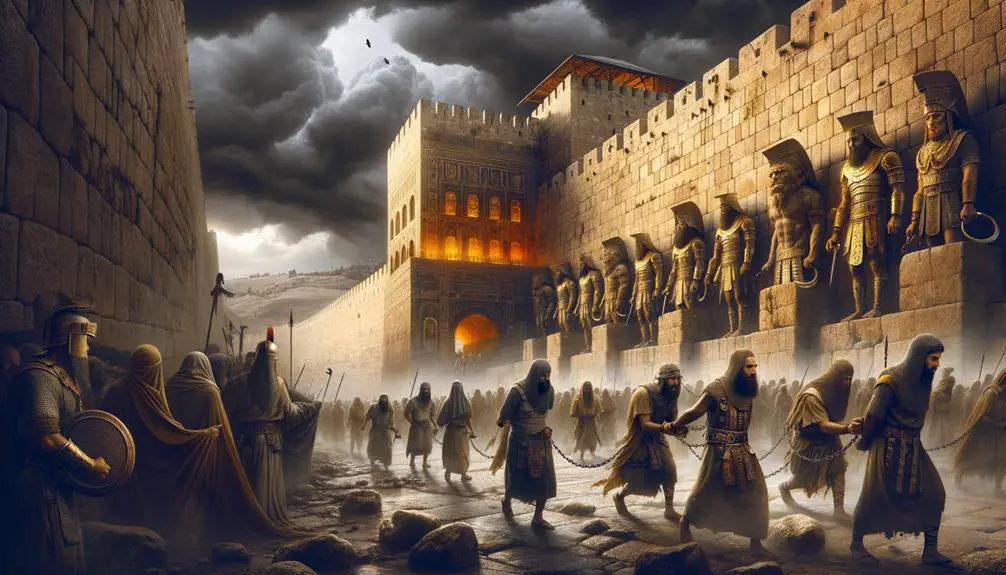
One pivotal moment in the history of Palestine, the Babylonian Exile, profoundly reshaped its religious and cultural identity. This event marked the period during which the Jewish people were held captive in Babylon following Nebuchadnezzar II's conquest of the Kingdom of Judah in 586 BCE. The exile had far-reaching impacts on the Jewish community, influencing theological perspectives, social structures, and the emergence of the Jewish diaspora.
To understand the significance of the Babylonian Exile, consider the following key points:
- Cultural and Religious Transformation: The exile served as a crucible for Jewish religious identity. Removed from their homeland and temple, the exiles found new ways to maintain their cultural practices and religious observances. This period saw the beginning of the synagogue as a place of worship and community, laying the foundation for Judaism as it's practiced today.
- Cyrus's Decree: In 538 BCE, Cyrus the Great of Persia conquered Babylon and issued a decree allowing the Jewish exiles to return to Palestine. This momentous edict facilitated the rebuilding of the Temple in Jerusalem and is often cited as a pivotal moment in Jewish history, symbolizing a new era of freedom and reconstruction.
- Emergence of the Jewish Diaspora: Although many exiles returned to their homeland, a significant number chose to remain in Babylon or migrate to other regions. This marked the beginning of the Jewish diaspora, a dispersion of Jewish people outside Palestine that would continue to influence Jewish culture and identity across centuries.
The Babylonian Exile, therefore, wasn't just a period of captivity but a transformative era that reshaped the Jewish faith, community, and identity in profound ways.
The Roman Period
Following the era of Babylonian influence and subsequent return under Cyrus's decree, the Roman period became another significant chapter in Palestine's complex history, marked by profound political and cultural changes. You'll find that the Roman era, spanning several centuries, introduced a series of administrative reforms that reshaped the socio-political fabric of the region. Central to these reforms was Roman taxation, a system that not only financed the Roman state but also had far-reaching implications for the local populace. This taxation mechanism often led to economic hardship among the residents, fostering a climate of discontent that would periodically erupt into rebellion.
Moreover, the Roman period was characterized by significant architectural influences that left a lasting legacy on Palestine's landscape. The Romans were renowned for their engineering prowess, and they brought this expertise to bear in Palestine through the construction of roads, aqueducts, and public buildings. These infrastructures facilitated the integration of Palestine into the wider Roman empire, enhancing trade and communication. However, it's crucial to recognize that these architectural marvels weren't merely functional; they also served as symbols of Roman power and civilization, intended to impress and, to some extent, subjugate the local population.
Analyzing the Roman period in Palestine, you grasp how external governance by a powerful empire introduced systemic changes that had both immediate and enduring impacts. Between the burdensome taxation and the architectural marvels, the Roman era contributed to shaping the historical trajectory of Palestine, weaving a complex tapestry of influence that would continue to be felt in subsequent periods.
Palestine in Jesus' Time
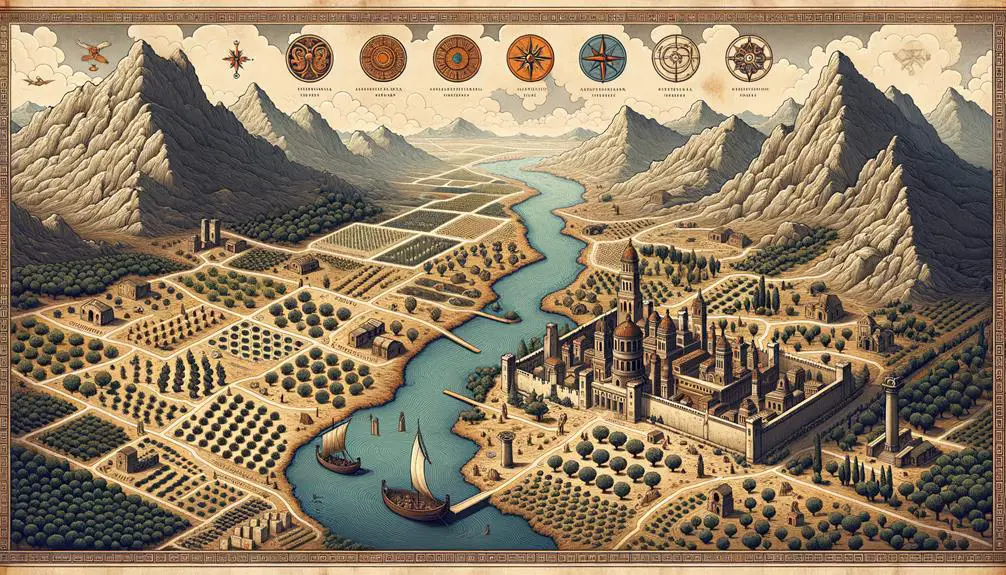
During the time of Jesus, Palestine was a region under Roman occupation, experiencing both the pressures of imperial control and the emergence of diverse religious movements. This context significantly influenced Jesus' teachings, which often addressed themes of justice, compassion, and resistance to oppression. Roman politics, with its complex interplay of power, also played a crucial role in the narrative of Jesus' life and ministry, shaping the socio-political landscape in which he operated.
The impact of Roman occupation and the socio-religious dynamics of Palestine during Jesus' time can be analyzed through three key aspects:
- Roman Governance and Taxation: The Roman Empire exerted its control through a network of local client kings and governors, who were responsible for maintaining order and collecting taxes. This system often led to exploitation and exacerbated the economic hardships faced by the common people, themes frequently addressed in Jesus' parables and teachings.
- Religious Diversity and Conflict: Palestine was a melting pot of religious beliefs and practices, with Judaism itself splintered into various sects such as the Pharisees, Sadducees, Essenes, and Zealots. Jesus' teachings challenged the established religious norms and authorities, advocating for a more personal and compassionate relationship with God.
- Roman Politics and the Crucifixion: The culmination of Jesus' ministry, his crucifixion, can't be divorced from the political context of Roman Palestine. Seen as a threat to Roman order and the stability of the cooperative Jewish leadership, Jesus' execution was a political act aimed at quelling potential unrest.
Understanding these dynamics enriches our comprehension of the historical backdrop against which Jesus' teachings and actions unfolded.
Frequently Asked Questions
How Did the Concept of "Holy Land" Evolve in Relation to Palestine as Referenced Throughout the Bible?
The concept of the 'holy land' in relation to Palestine evolved through biblical references, shaped by modern interpretations and geopolitical influences.
You'll find that as societies progressed, their understanding of sacred spaces transformed, integrating contemporary beliefs and political contexts.
This evolution reflects in scholarly analyses, which dissect how historical events and shifts in power dynamics influenced religious perceptions.
Thus, the 'holy land' embodies a complex interplay of faith, history, and politics.
What Were the Primary Languages Spoken in Biblical Palestine, and How Did They Influence the Spread of Religious Texts?
Imagine a tapestry, woven with threads of various colors, each strand representing a different language spoken in Biblical Palestine. This rich linguistic landscape, featuring Hebrew, Aramaic, and Greek, showcases the evolution of language over time.
The translation challenges these languages presented were significant, impacting the spread of religious texts. Scholars had to navigate this complex web, ensuring that the essence of sacred writings was preserved and understood across different cultures and eras.
Are There Any Significant Archaeological Discoveries in Palestine That Contradict or Challenge Biblical Narratives?
In exploring significant archaeological findings in the region, it's crucial to consider how climate impact and economic trade have shaped historical narratives.
Some discoveries indeed challenge traditional biblical accounts, offering new insights into ancient societies' adaptations and interactions.
How Did the Daily Life and Social Customs of Ordinary People in Biblical Palestine Differ From the Lives of Their Rulers and Religious Leaders?
In your exploration of daily life in ancient times, you'll find stark contrasts.
Ordinary people, deeply rooted in agricultural practices, led lives dictated by the seasons and their crops, a sharp contrast to their rulers and religious leaders who engaged in governance and spiritual rituals.
Family dynamics played a central role in the common folk's existence, weaving a complex social fabric that differed significantly from the elite's more isolated and ceremonious lifestyle.
What Role Did Women Play in the Religious and Societal Structures of Biblical Palestine, and How Are They Represented in Biblical Texts?
In biblical times, women played crucial roles within religious and societal structures. They were often depicted in texts as nurturers, influencers, or even leaders. You'll find accounts of female prophets who were pivotal, embodying spiritual authority and wisdom.
Additionally, maternal lineages held significant importance, shaping identities and heritage. Their representation in biblical narratives underscores their integral presence and contributions, challenging traditional perceptions of women's roles in ancient societies.
Conclusion
In analyzing the historical and biblical narrative of Palestine, it's evident that this region has been a crossroads of cultures, empires, and religions for millennia. The Israelite conquest, the kingdoms of Israel and Judah, and the impact of empires like the Babylonians and Romans have shaped its complex history.
Interestingly, archaeological evidence suggests that Jerusalem, a city within Palestine, has been inhabited for over 5,000 years, making it one of the oldest continuously inhabited cities in the world. This statistic highlights the deep historical roots and enduring significance of Palestine within the broader tapestry of human history.

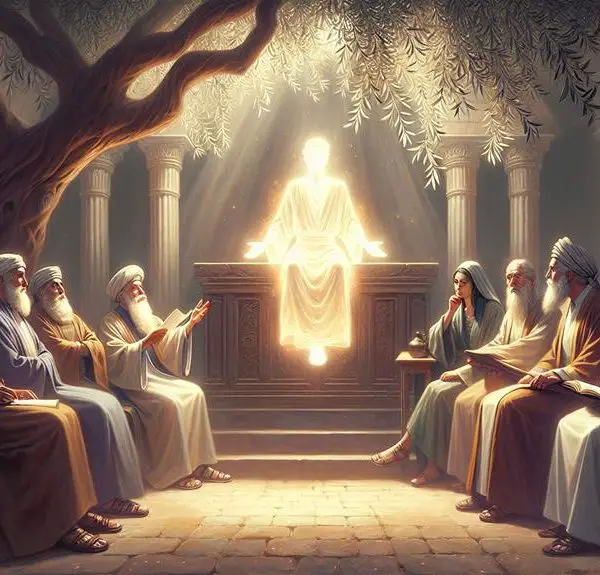

Sign up